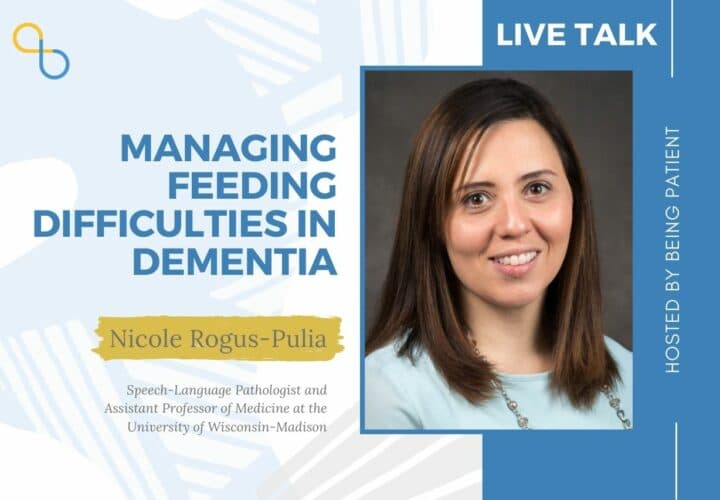As part of our LiveTalk series, Being Patient spoke with speech-language pathologist Nicole Rogus-Pulia about how dementia caregivers can better manage dysphagia and other eating difficulties.
When we swallow, we use muscles to move food and liquid from our mouth all the way down to our stomach, and that requires precise muscular coordination and input from the brain. For older adults living with dementia, age-related decline in muscle function can combine with neurodegeneration and result in swallowing conditions known as dysphagia.
Being Patient spoke with Nicole Rogus-Pulia, a speech-language pathologist and an assistant professor of medicine at the University of Wisconsin-Madison, about the common symptoms of dysphagia and caregiver strategies to help a loved one dine with dignity.
- Symptoms of dysphagia include throat-clearing during meals, changes in voice quality, loss of appetite and longer meal durations.
- Minimizing distractions, ensuring that the person with swallowing difficulties sit upright and presenting visually appealing meals are several strategies for caregivers to manage the feeding difficulties of the person under their care.
- Rogus-Pulia said people who notice signs of dysphagia should talk with their primary care physician, who can refer them to a speech-language pathologist for further examination and treatment.
Being Patient: What is dysphagia?
Nicole Rogus-Pulia: The term dysphagia refers broadly to the concept of swallowing dysfunction or impairment in the swallowing process. Typically when we think of swallowing, we think of the ability to move food and liquid through our mouth, through our throat and down into our esophagus, which is the tube that moves from our throat to our stomach. Dysphagia or difficulty swallowing can happen at any of those points in the swallowing process.
Being Patient: Why does it occur among people living with dementia?
Nicole Rogus-Pulia: The reason that we see dysphagia in persons with dementia is multifactorial. It has to do with the changes that are happening in the brain during the neurodegenerative process of dementia, but also there are changes that happen with advancing age. Given that dementia onset is usually in older individuals, there are changes that happen in muscle function. And, there are quite a few muscles and nerves that are involved in swallowing. The changes related to age plus the changes that are happening with the disease all combine to contribute to the onset of dysphagia.
Being Patient: What are the symptoms of dysphagia, especially in the earlier stages of dementia?
Nicole Rogus-Pulia: What we know about the onset of dysphagia in the early stages of dementia is that it often doesn’t manifest as more severe symptoms like coughing or choking. Sometimes it’s more subtle like clearing the throat during meals, something a lot of us wouldn’t necessarily even pay attention to. But subtle throat clears throughout a meal can indicate that there’s a little bit of sensation that something might be going down the wrong way.
A change in voice quality is another thing to pick up. If you hear a wet gurgly quality of voice or if you just know it sounds different during meals or after meals, that can be a sign that something has gone into the airway and materials are actually sitting on the vocal folds.
Another common symptom in early phase dementia could be aversion to eating. [It can be hard to spot] because there are also changes in appetite that happen as part of disease progression, but some of that aversion or desire not to eat could be because it’s not comfortable for the patient. So, longer meal durations to eat and avoidance of certain types of foods that the individuals enjoyed before [can be symptoms of dysphagia].
Being Patient: Difficulty in swallowing can lead to aspiration as food or fluids go into the lungs instead of the stomach, can you explain why it occurs and what the potential complications are?
Nicole Rogus-Pulia: When you swallow normally, there are a lot of different events that have to be coordinated during the swallow. One of the most important things that needs to happen is that you actually have to close your airway in the middle of the swallow … What ends up happening when someone has dysphagia is that those events are not well coordinated.
You move the material through the mouth, into the throat, and maybe the airway doesn’t close in time so it stays open, or the muscles that are responsible for closing the airway are weak and so you’re not actually able to close it effectively. Instead of the material staying out of the airway and going into the esophagus towards the stomach, some of that material will sneak into the airway. That’s what we call aspiration. When that happens, it moves down into the lungs, and then once it sits there, the body often can have trouble breaking it down. That can lead to an infectious process like pneumonia.
Being Patient: What are the steps people should take if they experience symptoms of dysphagia?
Nicole Rogus-Pulia: The best first step, if you think you or a loved one are experiencing issues related to dysphagia, would be to report some of those signs and symptoms to your primary care physician or the geriatrician that you’re working with, who can help get you connected with a speech-language pathologist.
We would do an evaluation that involves imaging the mouth and throat so that we can see what’s actually happening while you swallow. First, we’ll ask you some questions. We’ll try to get some medical history. We’ll try to understand what we’re observing from talking and working with you. Then, we want to actually be able to see what’s happening inside your body while you swallow. The medical term for that evaluation is the videofluoroscopic swallow study or the modified barium swallow. From there, we can recommend treatment that we think is going to be most effective. That’s going to be the best way to get connected with the right professional.
Outside of that, there are a lot of strategies that can be used to optimize swallowing function even without a known dysphagia diagnosis.
Being Patient: What are some of those strategies?
Nicole Rogus-Pulia: It’s very easy to become distracted [when we eat]. Most of us like to enjoy food and drinks with the people we care about. But for individuals with dementia, it’s really important to try to minimize distractions during mealtime: being in a quieter environment, not having the television on, maybe [playing] soft music in the background, thinking carefully about the number of eating partners and the expectations during the meal. Are you expecting this individual to actually converse with you and trying to keep conversation there for the social aspects of mealtime, but not having that be distracting. I’m sure many of your viewers will have had the experience where you’re trying to talk and swallow at the same time, it can be really difficult to coordinate those things. So, minimizing distractions as much as possible is important.
[We should] also be thinking about positioning for the patient. We lay back in a chair, we relax while we’re eating and sometimes we might even be lying down — those are not optimal positions. As much as possible, you want your loved one to be seated upright so that they can be in a really good position for eating and swallowing.
Gravity also plays an important role in moving materials through the mouth and the throat and the esophagus. Being upright will help to move things through the esophagus into the stomach more effectively.
Depending on the stage of progression, feeding techniques can also be really useful. Depending on whether the individual is able to feed themselves, we do try to encourage independence with feeding as much as possible.
If the individual is struggling to get food or liquid up to the mouth, there are different kinds of utensils that can be used to facilitate that.
[We should] also [think] about the visual presentation of food. If someone is on a pureed diet and you give them something that really looks unappetizing like giving pureed meats in a bowl when typically that wouldn’t be how they would eat meat, there can be an aversion to eating that. Thinking about the way that you present things that is visually appealing and also consistent with what the individual is used to are all important strategies.
The interview has been edited for length and clarity.




